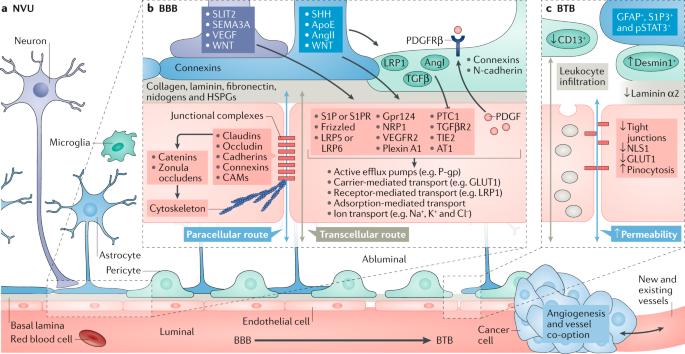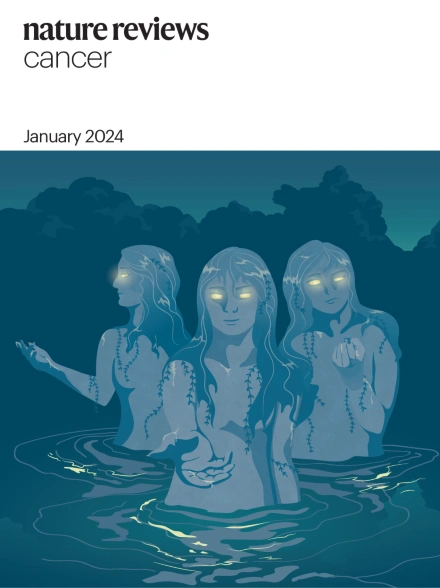The blood–brain barrier and blood–tumour barrier in brain tumours and metastases
IF 66.8
1区 医学
Q1 ONCOLOGY
引用次数: 731
Abstract
For a blood-borne cancer therapeutic agent to be effective, it must cross the blood vessel wall to reach cancer cells in adequate quantities, and it must overcome the resistance conferred by the local microenvironment around cancer cells. The brain microenvironment can thwart the effectiveness of drugs against primary brain tumours as well as brain metastases. In this Review, we highlight the cellular and molecular components of the blood–brain barrier (BBB), a specialized neurovascular unit evolved to maintain brain homeostasis. Tumours are known to compromise the integrity of the BBB, resulting in a vasculature known as the blood–tumour barrier (BTB), which is highly heterogeneous and characterized by numerous distinct features, including non-uniform permeability and active efflux of molecules. We discuss the challenges posed by the BBB and BTB for drug delivery, how multiple cell types dictate BBB function and the role of the BTB in disease progression and treatment. Finally, we highlight emerging molecular, cellular and physical strategies to improve drug delivery across the BBB and BTB and discuss their impact on improving conventional as well as emerging treatments, such as immune checkpoint inhibitors and engineered T cells. A deeper understanding of the BBB and BTB through the application of single-cell sequencing and imaging techniques, and the development of biomarkers of BBB integrity along with systems biology approaches, should enable new personalized treatment strategies for primary brain malignancies and brain metastases. This Review discusses the structure and function of the blood–brain barrier (BBB) and how brain tumours and brain metastases compromise BBB integrity. It also discusses the challenges the BBB poses for cancer therapy and how these might be overcome.

脑肿瘤和转移瘤的血脑屏障和血瘤屏障
血源性癌症治疗药物要想发挥疗效,就必须穿过血管壁,以足够的数量到达癌细胞,而且必须克服癌细胞周围的局部微环境所带来的阻力。脑部微环境会阻碍药物对原发性脑肿瘤和脑转移瘤的疗效。在本综述中,我们将重点介绍血脑屏障(BBB)的细胞和分子成分,BBB是为维持脑平衡而进化的专门神经血管单元。众所周知,肿瘤会破坏血脑屏障的完整性,从而形成一种被称为血-瘤屏障(BTB)的血管系统,这种屏障具有高度异质性,并具有许多不同的特征,包括非均匀渗透性和分子的主动外流。我们将讨论 BBB 和 BTB 给药物输送带来的挑战、多种细胞类型如何决定 BBB 的功能以及 BTB 在疾病进展和治疗中的作用。最后,我们重点介绍了改善 BBB 和 BTB 药物输送的新兴分子、细胞和物理策略,并讨论了它们对改善传统和新兴治疗方法(如免疫检查点抑制剂和工程 T 细胞)的影响。通过应用单细胞测序和成像技术加深对 BBB 和 BTB 的了解,以及开发 BBB 完整性的生物标志物和系统生物学方法,应能为治疗原发性脑恶性肿瘤和脑转移瘤提供新的个性化治疗策略。本综述讨论了血脑屏障(BBB)的结构和功能,以及脑肿瘤和脑转移瘤如何损害 BBB 的完整性。它还讨论了血脑屏障给癌症治疗带来的挑战以及如何克服这些挑战。
本文章由计算机程序翻译,如有差异,请以英文原文为准。
求助全文
约1分钟内获得全文
求助全文
来源期刊

Nature Reviews Cancer
医学-肿瘤学
CiteScore
111.90
自引率
0.40%
发文量
97
审稿时长
6-12 weeks
期刊介绍:
Nature Reviews Cancer, a part of the Nature Reviews portfolio of journals, aims to be the premier source of reviews and commentaries for the scientific communities it serves. The correct abbreviation for abstracting and indexing purposes is Nat. Rev. Cancer. The international standard serial numbers (ISSN) for Nature Reviews Cancer are 1474-175X (print) and 1474-1768 (online). Unlike other journals, Nature Reviews Cancer does not have an external editorial board. Instead, all editorial decisions are made by a team of full-time professional editors who are PhD-level scientists. The journal publishes Research Highlights, Comments, Reviews, and Perspectives relevant to cancer researchers, ensuring that the articles reach the widest possible audience due to their broad scope.
 求助内容:
求助内容: 应助结果提醒方式:
应助结果提醒方式:


